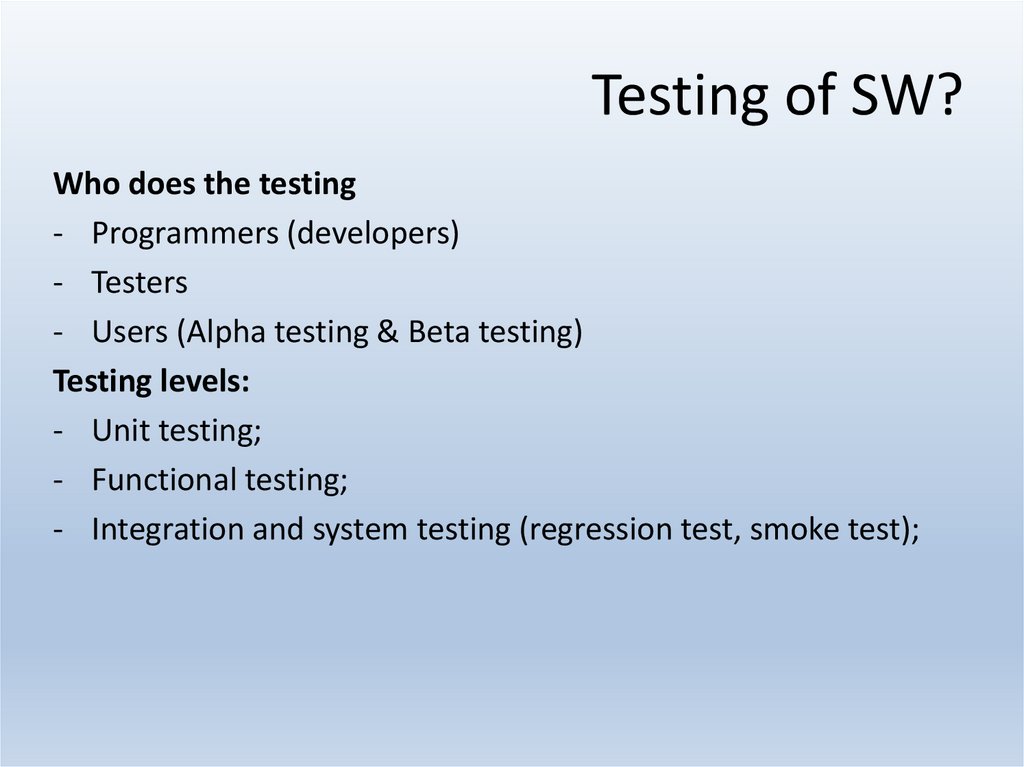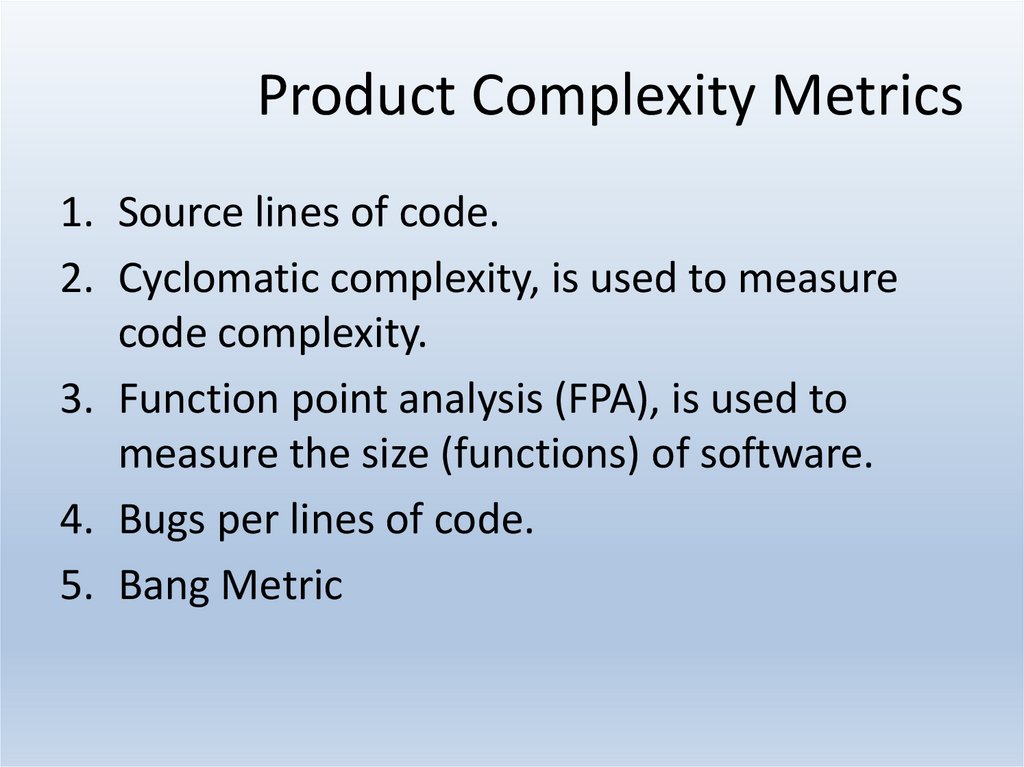Similar presentations:
Principles of project management and staff recruitment
1. Principles of PROJECT MANAGEMENT and staff recruitment
PRINCIPLES OF PROJECTMANAGEMENT AND STAFF
RECRUITMENT
QUALITY ASSURANCE AND TESTING.
Lecturer:
Alin G.T.
Instructor: Rakhimzhanova N.K.
2. Outline
Software Quality Assurance Plan
Definition of quality for software products
Software Metrics
Software Testing, types of testing
3. Outcomes
• Understand the key parts of the SoftwareTesting process
• Know how to identify the metrics of software
• Be able to write a SQAP
• Have a clear understanding of what is Quality
in software products
4. Software Quality Assurance Plan
The purpose of the Software QualityAssurance Plan (SQAP) is to define the
techniques, procedures, and methodologies that
will be used at project to assure timely delivery
of the software that meets specified
requirements within project resources.
5. Software Quality Assurance Plan
Set common templates (standards)
Define the sequence of actions
Ensure that standards and processes are used
Conduct an analysis of completed projects
Analyze and learn, using the defect data
Use what you have learned
6. What is Quality?
• How do you understand the term Qualityof software product?
• Is it rather about conformance to
requirements?
• Is it rather about fitness of use?
7. What is Quality?
• Verification – The evaluation of whether or not aproduct, service, or system complies with a regulation,
requirement, specification, or imposed condition. It is
often an internal process. Contrast with validation.
• Validation -The assurance that a product, service, or
system meets the needs of the customer and other
identified stakeholders. It often involves acceptance
and suitability with external customers. Contrast
with verification.
8. Fault, failure and error
Fault/defect – a condition that may cause afailure in a system, also called a bug.
Failure/problem – the inability of a system to
perform a function according to its specification,
result of a defect.
Error – a mistake made by software engineer or
programmer
9. Cost of Quality (CoQ)
10. Software Project Metrics
Tools for anyone involved in software engineering tounderstand varying aspects of the code base, and the project
progress.
They are different from just testing for errors because they
can provide a wider variety of information about the following
aspects of software systems:
Quality of the software, different metrics look at different aspects of
quality
Schedule of the software project on the whole, some metrics look at
functionality and some look at documents produced.
Cost of the software project. Includes maintenance, research and typical
costs associated with a project.
Size/Complexity of the software system. This can be either based on
the code or at the macro-level of the project and it’s dependency on other
projects.
11. Seven basic Quality tools
12. Software Metrics: effects of proper usage
Reduce cost by 15% - 20% by just measuringCreate baseline of quality and productivity
and compare against industry averages.
Pinpoint opportunities for improvement.
Ability to measure initiatives and measure ROI
(return of investments).
13. Software Project Metrics: types
Life Cycle Step metricsCosts and budget metrics
Requirements’ change metrics
Development process metrics
Testing metrics
Defect metrics
Efficiency metrics
14. Software Project Metrics in Agile
• An agile version of the Goal QuestionMetric (GQM) strategy.
• The fundamental idea behind GQM is that
you first identify:
– a goal that you would like to achieve,
– a set of questions whose answers are
pertinent to determining how well you’re
achieving that goal,
– and then the metric(s) that could help you to
answer each question
15. Software Project Metrics
General Project Metrics:1. Completed activities budget (percentage of completed tasks)
2. Actual budget ratio of the planned budget ( Budget(actual) /
Budget(planned) )
3. Dispersion (var) of costs (Budget(actual) - Budget(planned) )
4. Schedule execution ( Effort (actual) / Effort (planned) )
5. Dispersion (var) of schedule ( Effort (actual) - Effort (planned) )
6. Schedule delays ( ∑ delay time )
7. Coefficient of closed tasks ( closed tasks / planned tasks)
8. Productivity
16. Software Metrics
Requirements Metrics:Frequency of change in the total requirements set
Rate of introduction of new requirements
Traceability
Volatility of requirements
Percentage of defects as requirement as a root cause
Number of requirement-related change requests
Requirement Stability Index : 1- ((No of changed + No
of deleted + No of added) / Total no of Initial
requirements) x100
17. Software Metrics
Process Metrics:18. Software Metrics
Product Metrics:Testing
General
Testing time
Test cases metrics
Passed/Failed Test Cases
Not Run Test Cases
Bugs
Open/Closed Bugs
Reopened/Closed Bugs
Rejected/Opened Bugs
Bugs by Severity
Bugs by Priority
19. What is Testing of SW?
Maintaining a set of techniques for detectingand correcting errors in a software products
(testing process can be automated)
Testing should be applied to all artifacts of software
projects development.
20. Testing
Test Plan - a document describing the scope,approach, resources and schedule of intended test
activities. It identifies amongst others test items, the
features to be tested, the testing tasks, who will do each
task, degree of tester independence, the test
environment, the test design techniques and entry and
exit criteria to be used, and the rationale for their choice,
and any risks requiring contingency planning. It is a record
of the test planning process.
21. Testing
• Master Test Plan: A single high-level test plan for aproject/product that unifies all other test plans.
• Testing Level Specific Test Plans: Plans for each level of
testing.
–
–
–
–
Unit Test Plan
Integration Test Plan
System Test Plan
Acceptance Test Plan
• Testing Type Specific Test Plans: Plans for major types
of testing like Performance Test Plan and Security Test
Plan.
22. Testing of SW?
Who does the testing- Programmers (developers)
- Testers
- Users (Alpha testing & Beta testing)
Testing levels:
- Unit testing;
- Functional testing;
- Integration and system testing (regression test, smoke test);
23.
24. Testing of SW?
Testing purposes:- Acceptance testing
- Conformance testing
- Configuration testing;
- Performance testing;
- Stress testing;
- User interface testing
Test cases based on:
• Intuition
• Specification (known as black-box testing)
• Code (white-box testing)
• Existing test cases
• Faults
25. Requirements Traceability Matrix
Requirement Traceability Matrix – Parameters include• Requirement ID
• Risks
• Requirement Type and Description
• Trace to design specification
• Unit test cases
• Integration test cases
• System test cases
• User acceptance test cases
• Trace to test script
26. Requirements Traceability Matrix
27. Requirements Traceability Matrix
28. Requirements Traceability Matrix
29. Requirements Traceability Matrix
30. Requirements Traceability Matrix
31. Requirements Traceability Matrix
32. Requirements Traceability Matrix
33. Product Complexity Metrics
1. Source lines of code.2. Cyclomatic complexity, is used to measure
code complexity.
3. Function point analysis (FPA), is used to
measure the size (functions) of software.
4. Bugs per lines of code.
5. Bang Metric
34. Reading assignments
1. Software Project Survival Guide By SteveMcConnell Microsoft Press, Chapter 9
2. Essentials of Software Engineering By Frank
Tsui , Orlando Karam Jones & Bartlett Learning,
Chapter 10
3. A Guide to the Project Management Body of
Knowledge. Chapter 6


































 management
management








